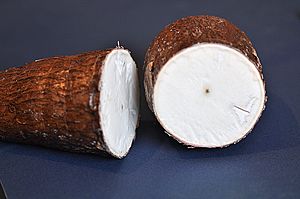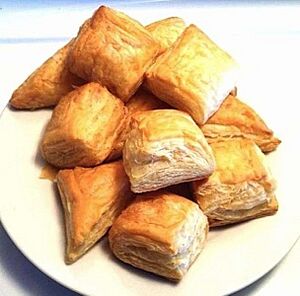Haitian cuisine facts for kids
Haitian cuisine is all about the yummy food and cooking styles from Haiti. It's a special kind of cooking called 'Creole cuisine.' This means it's a mix of different food traditions that came together on the island of Hispaniola. These traditions include African, French, Spanish, and even some from the native Taíno people and Arab cultures. Haitian food is a lot like other 'Creole' foods in the Latin Caribbean, but it has its own unique twists!
The flavors in Haitian dishes are often bold and a little spicy. This shows the strong influence from African and French cooking. You can also find hints of flavors and cooking methods from the original Taíno people and the Spanish. Over time, even foods from the Middle East became part of Haitian cooking because many Arab families moved there.
Contents
How Haitian Food Started: A Look at History
Ancient Flavors: Taíno Cooking
Long ago, Haiti was home to the Taíno people. They spoke a language called Taíno. Guess what? The idea of barbecue actually started with them in Haiti! The word 'barbecue' comes from their word barabicu. This word meant a wooden frame set on posts.
Spanish explorers arrived in 1492. They saw the Taíno people cooking meat over a grill made of wood. Fire and smoke would rise, giving the meat a special flavor. The Taíno also used these frames to protect themselves from wild animals at night. This barbecue cooking style not only stayed in Haitian food but also spread all over the world!
New Influences: Colonial Times
In 1492, Christopher Columbus landed in Haiti and claimed the island for Spain. The Spanish started large sugar farms and made the native Taíno people work there. Sadly, many Taíno people died from hard work and new diseases brought by the Spanish.
So, the Spanish brought enslaved people from Africa to work on the farms instead. These African people brought many new foods to Haiti. They introduced foods like okra (a green pod), ackee (a red and yellow fruit), taro (a root vegetable), pigeon peas, and many different spices.
Later, in 1697, the French took control of the western part of the island. They grew sugarcane, coffee, cotton, and cocoa using enslaved African labor. When Haiti became independent from France in 1804, many people moved to places like New Orleans. They brought Haitian foods like red beans and rice and chayote (a pear-shaped vegetable) with them. Even today, French foods like cheeses, breads, and desserts are still very common in Haiti.
What Ingredients Are Popular in Haitian Cooking?
Haitian cooks use many fresh and flavorful ingredients. Here are some of the most popular ones:
- Avocado
- Banana
- Beef
- Black beans
- Cabbage
- Carrot
- Cassava (also called 'cassave')
- Chicken
- Chayote
- Cinnamon
- Coconut milk
- Cod fish
- Cornmeal
- Crab meat
- Dried and salted cod
- Eggplant
- Ginger
- Goat meat
- Guava
- Habanero pepper
- Kidney beans (red beans)
- Lemon
- Mango
- Onion
- Okra
- Papaya
- Parsley
- Pork
- Pigeon peas
- Pineapple
- Plantain
- Rice
- Scotch bonnet pepper
- Shrimp
- Sour orange
- Spinach
- Sweet potato
- Taro root
- Tomato sauce
- Vinegar
- Yam
What Are Some Popular Haitian Dishes?
Haitian food has its own special taste, even though it's sometimes grouped with other Caribbean foods. Haitian cooks use lots of fresh herbs and plenty of peppers!
A typical Haitian meal might be riz collé aux pois (diri kole ak pwa). This is rice cooked with red kidney beans (or pinto beans). It's often served with a tasty sauce and topped with fish like red snapper, tomatoes, and onions. Many people call it the Riz National because it's so important to Haiti's food culture.
Sometimes, rice is eaten with just beans. But usually, some kind of meat is added to make the meal complete. A thick bean sauce called sauce pois (sos pwa) is often poured over white rice. Black beans are a common choice for this sauce, but red beans, white beans, and even peas are also used.
Chicken is eaten very often. So are goat meat (cabrit) and beef (boeuf). Chicken is usually boiled in a flavorful marinade. This marinade often includes lemon juice, sour orange, Scotch bonnet pepper, garlic, and other seasonings. After boiling, the chicken is often fried until it's crispy and delicious.
Légume Haïtien (or just "légume") is a thick vegetable stew. It's made from a mashed mix of vegetables like eggplant, cabbage, chayote, spinach, and watercress. The exact vegetables depend on what's available and what the cook likes. It's flavored with a special mix of spices called épice, onions, garlic, and tomato paste. It's usually cooked with beef or crab. Légume is most often served with rice. But it can also be eaten with other starchy foods like mais moulin (a cornmeal porridge like polenta) or petit mil (cooked millet).
Other starchy foods that Haitians enjoy include yams, patate (a type of sweet potato), potatoes, and breadfruit. These are often eaten with a thin sauce made from tomato paste, onions, spices, and dried fish.
Tchaka is a warm and hearty stew. It's made with hominy, beans, joumou (squash), and meat, often pork. Boulette are meatballs seasoned in the Haitian style and often bound with bread.
Did you know spaghetti is often eaten for breakfast in Haiti? It's cooked with hot dogs, dried herring, and spices. Then it's served with tomato sauce and sometimes fresh watercress.
One of Haiti's most famous appetizers is the Haitian patty (pâté). These are made with a crispy or flaky crust. Inside, they can be filled with ground beef, salted cod, smoked herring, or ground turkey. They are seasoned for a bold and spicy flavor. Other tasty snacks include crispy, spicy fried malanga fritters called accra (akra). There are also bananes pesées (flattened fried plantains) and marinade (fried savory dough balls).
For a full meal, these snacks can be served with griot (fried pork) or tassot cabrit (fried goat meat). These fried foods are often served with a spicy slaw called pikliz. Pikliz is made with cabbage, carrot, vinegar, Scotch bonnet pepper, and spices. Fried foods, known as fritaille (fritay), are sold everywhere on the streets.
Special Dishes from Different Regions
Haiti also has special dishes that are popular in certain areas. In the region of Jérémie, you can find a dish called tonmtonm. This is steamed breadfruit that is mashed in a special tool called a pilon. People usually swallow tonmtonm without chewing it. They eat it with a slippery sauce made of okra (kalalou), cooked with meat, fish, crab, and savory spices. Tonmtonm is very similar to West African fufu.
Another regional dish is poul ak nwa (poulet aux noix de cajou). This is chicken with cashew nuts. It comes from the northern part of the country, near Cap-Haïtien.
New people moving to Haiti have also brought new foods. For example, immigrants from Lebanon and Syria introduced kibbeh, which is now a part of Haitian cooking.
The main flavor base for much Haitian cooking is épice. This is a special sauce made from cooked peppers, garlic, and herbs. Common herbs include green onions, thyme, and parsley. Épice is used as a basic seasoning for rice and beans, and it's also added to stews and soups. Many Haitian cooks also use bouillon cubes, especially the Maggi brand.
What Foods Are Popular in Different Parts of Haiti?
| Department | Dish |
|---|---|
| Artibonite | Lalo Stew and White Rice |
| Centre | Goat meat and Turkey Meat |
| Grand'Anse | Tonmtonm with okra stew |
| Nord | Chicken stew with cashew nuts and Djondjon Rice |
| Ouest | Rice and Peas with Griot, Haitian Patties, Haitian Spaghetti |
| Sud-Est | Poisson Gros-de-Sel |
| Sud | Conch and Fish |
What Do Haitians Drink?
Because Haiti has a tropical climate, fresh juice is a very common drink. You can find juices made from many different fruits everywhere! People enjoy guava juice, grapefruit juice, mango juice, and juices from many citrus fruits like orange and passion fruit. Juice is a favorite drink because there are so many flavors, and it's easy to make and find.
Malt beverages are also popular. These are non-alcoholic drinks made from unfermented barley with molasses added for flavor. Cola Couronne, a fruit champagne-flavored soda, is probably the most popular soda in Haiti. It has been a favorite since 1924. Cola Lacaye is another soda brand with many different fruit flavors. In bigger cities, American drinks like Coca-Cola and Pepsi are also enjoyed.
Milkshakes (or milkchèyk) are also drunk regularly. Strong, sweet coffee is a favorite throughout the country. Brands like Café Selecto (since 1898) and Rebo offer great coffee blends. Haitian coffee has a classic, rich taste with hints of chocolate and mellow citrus. Jus Papaye is a Haitian papaya juice milkshake flavored with vanilla. Akasan is another popular drink made with milk, corn flour, anise stars, vanilla, and cinnamon.
Sweet Treats: Haitian Desserts
Haiti has many types of desserts, from mild to very sweet. Sugarcane is often used to make these desserts, but granulated sugar is also common.
Fresco is a shaved ice dessert, similar to an Italian ice. It's mostly made with fruit syrup. Pain patate (pen patat) is a soft, sweet bread made with cinnamon, evaporated milk, and sweet potato. It's usually served cold, but you can also eat it at room temperature.
Akasan is a thick corn milkshake. It has a texture like labouille (labouyi), which is a type of cornmeal porridge. It uses many of the same ingredients as pain patate, like evaporated milk and sugar. Dous makos is a Haitian vanilla fudge.
A List of Haitian Dishes
Here are some more delicious Haitian dishes:
- Bouillon (a hearty soup)
- Cassave or kasav (flatbread made from dried cassava, sometimes with sweetened coconut)
- Chocolat des Cayes or Chokola La Kaye (homemade cocoa)
- Doukounou (a cornmeal pudding that is neither sweet nor savory)
- Du riz blanche a sause pois noir or diri blan ak sos pwa nwa (white rice with black bean sauce)
- Du riz djon djon or diri ak djon djon (rice cooked in a black mushroom sauce)
- Du riz a légume or diri ak legim (rice with vegetable stew)
- Du riz a pois or diri ak pwa (rice and beans)
- Du riz a pois rouges or diri ak pwa wouj (rice with red beans)
- Du riz a sauce pois or diri ak sos pwa (rice with bean sauce)
- Griot (seasoned fried pork with scallions and peppers in a sour orange sauce)
- Macaroni au Gratin (Haitian macaroni and cheese)
- Marinade (fried savory dough balls)
- Mud cookie (a special type of cookie)
- Pain Haïtien (Haitian Bread)
- Pâté Haïtien (Haitian patty) - A very popular savory snack with a delicate puff pastry. It's stuffed with ground beef, salted cod, smoked herring, chicken, or ground turkey, all seasoned for a bold and spicy flavor.
- Peanut Pralines (sweet peanut candies)
- Picklese or Pikliz (a slaw-like condiment made with spicy pickled cabbage, onion, carrot, and Scotch bonnet peppers)
- Salade de Betteraves (Beet salad)
- Sauce Ti-Malice or Sos Ti-Malice (a spicy, tangy sauce often served over Griot or Cabrit)
- Soup joumou (a special pumpkin soup)
- Tassot et bananes pesées or Taso ak bannann peze (Fried Goat and fried plantains)
- Tostones (double-fried plantain slices)
- Poul an Sòs (Chicken in Creole Sauce)
- Potato Gratine' (baked potato dish)
- Salad Rus (a salad with beets, potato, and egg)
|
See also
 In Spanish: Gastronomía de Haití para niños
In Spanish: Gastronomía de Haití para niños









